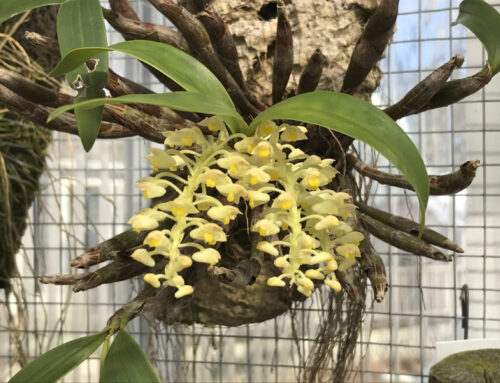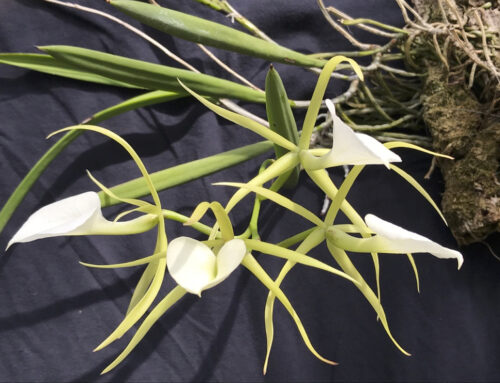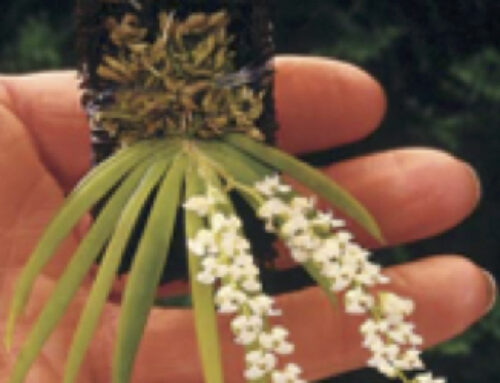By Thomas Mirenda
Family Gatherings and Grilling Bring Together the Holiday Spirit
Summer fun reaches its peak in July, with the hot weather finally arriving and sunscreen flying off the shelves. For kids, it just doesn’t get any better than July — barbeques, cooling off in the sprinkler or pool by day and backyard fireworks displays by night. Occasionally, there will be the unusual child who gravitates away from all the hullaballoo in the backyard and finds that shady spot where orchids are growing. With bursts of Epidendrum and brassia flowers and huge cornet like scapes of glowing encyclia and myrmecophila blossoms reaching skyward, many a budding interest in orchids has been ignited by the fascinating array of plants in bloom this month. Keep an eye out for those young ones who see the miracles of nature as more than rivals for the glitzy fireworks, but as the true marvels they are. Take the time to nurture and perhaps share a plant or two with a youthful relative or neighborhood nature child.
Heat
With temperatures often rising into the 90s, many orchid plants are stressed. Large and tender new growths generated this past spring are maturing and hardening off but are still susceptible to sunburn, heat stress and fungal infections. Therefore, the bulk of our activities this month are related to minimizing the effects of heat on our plants.
Read About Plants
Many orchids, particularly those from seasonally dry forests, such as encyclias, myrmecophilas and brassavolas, seem to do well in the summer heat. Even the many deciduous Dendrobium species and hybrids that require cool winter temperatures are growing rampantly now. Their adaptations of extreme succulence and large pseudobulbs give them the ability to withstand heat and dryness better than orchids from more seasonally uniform habitats like montane tropical rainforests, such as miltonias, many paphiopedilums, pleurothallids and even phalaenopsis. These orchids tend to have smaller pseudobulbs, or none, and have less succulent foliage. For these plants, shade and hydration during the summer heat is a real necessity.
Cooling Plants
Basically, there are three strategies for cooling off your plants: shading, misting and air flow. All of these strategies either separately or combined can ease the stresses of summer heat on orchids significantly. But taken to excess, these heat defenses can do more harm than good.
Shading
Most of our orchids benefit from some shading during the hottest months, but many also need bright light to grow strongly and store enough nutrients to bloom once their new growths have matured. Cattleyas, cymbidiums, standard dendrobiums and vandas will languish with weak and spindly new growths if kept constantly in deep shade. For such plants, misting and air flow are better strategies for cooling. For phalaenopsis and most pleurothallids, deeper shade gives better results.
Misting
Many high-light orchids, notably vandas and cymbidiums, benefit from a fine cooling mist at the height of the day’s temperatures. Feel your orchid’s leaves on a hot day. If they are hot to the touch, they have shut down and are in danger of burning. Just a quick wetting down with a light mist is often enough to cool the leaves down. Cymbidiums in particular seem to grow better when cooled in this way. Automatic misting systems are available for both outdoor and greenhouse growers. Still, beware of wetting down leaves in full sun, as the water can overheat or act like a lens. This usually happens only under glass or on window sills where the air flow is poor. The other danger with misting is waterlogging your plants. Don’t mist so much that your plants never dry between waterings. Also, remember that water sitting in the new growths of your phalaenopsis plants at night is a sure recipe for the dreaded crown rot.
Air Flow
Perhaps the most important and overlooked aspect of cooling is air movement. A beam of light hitting a thermometer will make it register much higher than the actual ambient temperature. The same is true of leaves. If light hits the same portion of a leaf on a hot day with no breeze to cool it, it will overheat and burn quickly. But if a light moist breeze is caressing your plants, it will dissipate this heat. This can also be done to excess, for example, if the air movement is too strong, it can prevent plants from taking in carbon dioxide, or cause desiccation.
Microclimates
Put maximum/minimum thermometers and monitor the light and air flow in various spots of your growing areas. You’ll be surprised at how much they can vary. You might find, for example, that the sunny south side of your greenhouse near the exhaust fan is a prime spot for dendrobiums. Or the cool, breezy spot under the beech tree is ideal for the miltoniopsis. There is a copper beech tree near our facility here in Washington, DC., where legend has it that Abraham Lincoln used to like to sit and write because it was 10 degrees cooler under that tree than anywhere else in the infamously torrid DC summer. There may be spots like that in your own back yard. Seek them out. Those are great spots to summer your orchids.
Fertilizing
Even though your plants have been growing so well these last few months, beware of fertilizing on hot days. When plants overheat, they shut down metabolism and basically stop growing. If their medium and roots are imbued with plentiful, but unused, fertilizer, it can sour your mix and burn your roots. Take the time to leach your plants of excess fertilizer salts, and use plant foods sparingly (if at all) during excessively hot weather.
—
Originally published in Orchids Magazine – July 2006
Thomas Mirenda is the orchid collection specialist at the Smithsonian Institution and an AOS judge. 3000 Cedar Lane, Fairfax, Virginia 22031






